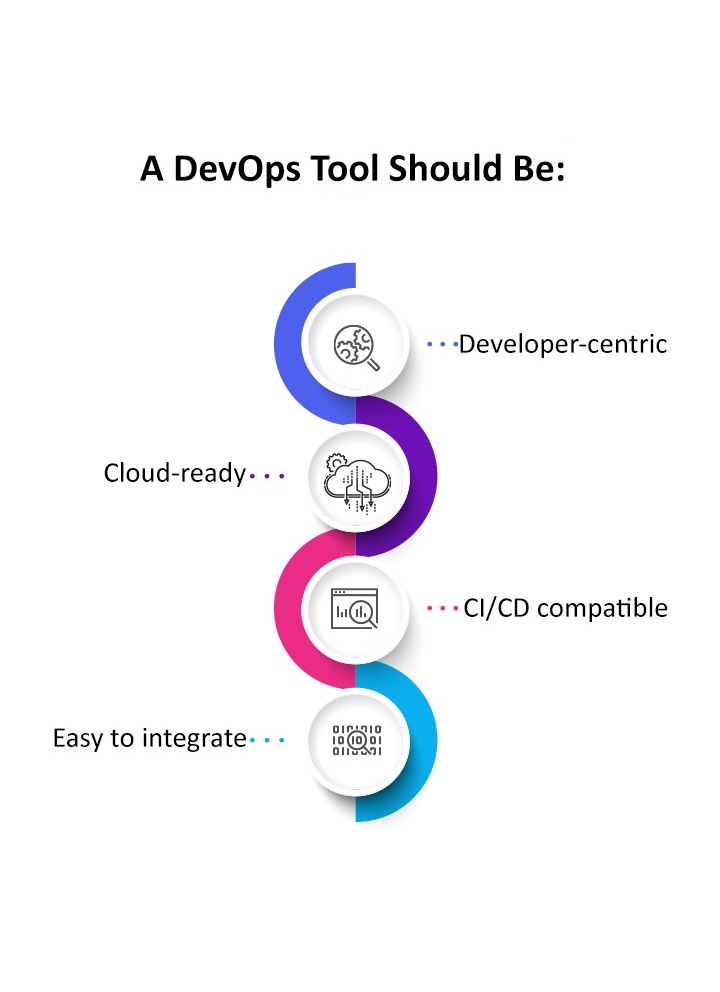DevOps
DevOps is a set of practices that combines software development (Dev) and IT operations (Ops) to create a faster and more reliable software development process.

DevOps is a set of practices that combines software development (Dev) and IT operations (Ops) to create a faster and more reliable software development process.
DevOps is a set of practices that combines software development (Dev) and IT operations (Ops) to create a faster and more reliable software development process. The goal of DevOps is to bridge the gap between development and operations teams by fostering a collaborative and integrated approach to software delivery.
The DevOps approach emphasizes the automation of software deployment, testing, and infrastructure management, as well as the continuous delivery of software updates. By automating the software development process, DevOps aims to reduce the time it takes to bring new features to market while improving software quality, reliability, and security.
DevOps practices often involve the use of technologies such as continuous integration and continuous delivery (CI/CD), configuration management tools, containerization, and cloud computing. DevOps teams may also use agile methodologies to prioritize and manage software development tasks.
Overall, DevOps is an approach to software development that emphasizes collaboration, automation, and continuous delivery to improve software quality, reliability, and speed of delivery.
DON’T FOLLOW DIGITAL TRENDS. START THEM.
There are different types of DevOps that can be applied depending on the specific needs and goals of a software development project. Some common types of DevOps include:
Development-focused DevOps: This type of DevOps emphasizes the software development process and involves close collaboration between development and testing teams. The focus is on improving code quality, automating testing, and enabling continuous integration and delivery.
Operations-focused DevOps: This type of DevOps emphasizes the operational aspects of software delivery and involves close collaboration between operations and development teams. The focus is on improving infrastructure automation, monitoring and logging, and enabling rapid deployment and scaling.
Security-focused DevOps: This type of DevOps emphasizes security throughout the software development lifecycle and involves close collaboration between security and development teams. The focus is on integrating security into the development process, identifying and mitigating security risks, and ensuring compliance with security standards and regulations.
Data-focused DevOps: This type of DevOps emphasizes the use of data analytics and machine learning to improve software delivery and performance. The focus is on using data to inform development decisions, automate testing and deployment, and optimize infrastructure and operations.
Cloud-focused DevOps: This type of DevOps emphasizes the use of cloud computing services to enable rapid deployment, scaling, and automation of software delivery. The focus is on leveraging cloud infrastructure and services to reduce costs, improve reliability, and enable rapid experimentation and innovation.
Overall, the type of DevOps adopted will depend on the specific needs and goals of a software development project. It is important to have a clear understanding of the project requirements and to select the appropriate DevOps approach to achieve the desired outcomes.

DevOps is a set of practices that aim to improve collaboration between software development and IT operations teams, resulting in faster and more reliable software delivery. The term “DevOps” itself was coined in 2009 by Patrick Debois, a Belgian IT consultant, who organized the first “DevOpsDays” conference in Ghent, Belgium.
The origins of DevOps can be traced back to the agile software development movement that emerged in the early 2000s. Agile methodologies emphasized the importance of collaboration, iterative development, and continuous delivery, which laid the groundwork for the DevOps approach.
The traditional approach to software development involved a “waterfall” model, in which software was developed in a linear sequence of phases, starting with requirements gathering, followed by design, development, testing, and deployment. This approach resulted in long development cycles, with little collaboration between teams and a high risk of errors.
With the emergence of agile methodologies, software development teams began to collaborate more closely and deliver software updates more frequently. However, there was still a gap between development and operations teams, which often resulted in delays and errors during deployment.
The DevOps lifecycle emerged as a way to bridge this gap and create a more efficient and collaborative software development process. The DevOps lifecycle typically includes the following stages:
Overall, the DevOps approach emphasizes collaboration, automation, and continuous delivery to improve software quality, reliability, and speed of delivery.
Better insight of business data from various aspects, enhance operation and increase sales. Recent AI Insights into artificial intelligence, machine learning, and beyond.
WDG is helping companies worldwide achieve blockchain implementation for education, ideation, strategy, prototyping, and development. Information to be recorded and distributed.
We are able to deliver different services through the Internet or cloud computing. These resources include tools and applications like data storage, servers, databases, networking, and software.
ERP refers to a software that organizations use to manage day-to-day business activities such as accounting, project management, risk management, and supply chain operations.
We'll update you with new in Artificial Intelligence, Machine Learning, Robotic Process Automation, Edge Computing, Quantum Computing, Virtual Reality and Augmented Reality, Blockchain & IoT
Security refers to methods, tools used to defend an organization's digital assets. The goal of security is to protect assets and services from being disrupted, stolen or exploited by unauthorized users

Yes, DevOps can provide value for money by improving the efficiency, quality, and speed of software development and delivery. By adopting DevOps practices, organizations can reduce the time and cost of software development, while improving the reliability and security of their software products.
Here are some ways that DevOps can provide value for money:
Automation: DevOps emphasizes the automation of software development and delivery processes, which can reduce the time and cost of manual tasks and improve the accuracy and consistency of software development.
Collaboration: DevOps encourages close collaboration between development and operations teams, which can improve communication and reduce errors and delays in the software development process.
Continuous Integration and Delivery (CI/CD): DevOps enables the use of continuous integration and delivery (CI/CD) pipelines, which can automate the testing, building, and deployment of software updates. This can reduce the time and cost of software delivery, while improving software quality and reliability.
Infrastructure as Code (IaC): DevOps promotes the use of Infrastructure as Code (IaC), which involves defining infrastructure and configuration settings in code. This can improve the efficiency and accuracy of infrastructure management, while reducing the risk of manual errors.
Cloud Computing: DevOps encourages the use of cloud computing services, which can reduce infrastructure costs, improve scalability and availability, and enable rapid experimentation and innovation.
Overall, by adopting DevOps practices, organizations can improve the value for money of their software development projects by reducing the time and cost of software delivery, improving software quality and reliability, and enabling rapid innovation and experimentation.

The main difference between traditional or “normal” software development and DevOps development lies in the approach to collaboration, automation, and continuous delivery.
In traditional software development, there is often a separation between development and operations teams, with each team working in isolation and handing off work to the other team. This can lead to delays, errors, and miscommunications, resulting in longer development cycles and slower delivery times.
In contrast, DevOps emphasizes collaboration between development and operations teams, with a focus on automating processes and enabling continuous delivery. This approach can result in faster, more reliable software delivery, as well as improved communication and teamwork between teams.
Here are some key differences between traditional and DevOps development:
Team structure: In traditional development, development and operations teams often work in silos. In DevOps, these teams work closely together in a collaborative environment, with a shared responsibility for delivering software.
Approach to software delivery: In traditional development, software is often delivered in large, infrequent releases. In DevOps, software is delivered in small, frequent releases, using continuous integration and delivery (CI/CD) pipelines.
Automation: DevOps emphasizes the use of automation to reduce the time and effort required for manual tasks, such as testing and deployment. In traditional development, manual tasks are more common and can be time-consuming and error-prone.
Monitoring and feedback: DevOps places a strong emphasis on monitoring and feedback, using tools such as log analysis and performance metrics to identify issues and make improvements. In traditional development, monitoring and feedback may be less frequent or less automated.
Overall, DevOps development differs from traditional development in its emphasis on collaboration, automation, and continuous delivery. This approach can lead to faster, more reliable software delivery, as well as improved communication and teamwork between development and operations teams.






End-to-end DevOps development is a software development approach that covers the entire software development lifecycle, from planning and development to testing, deployment, and operations. The goal of end-to-end DevOps is to enable continuous delivery of software, with a focus on automation, collaboration, and feedback.
Here are the main stages of an end-to-end DevOps development process:
Plan: In this stage, the development team works with stakeholders to define project goals, identify requirements, and create a plan for software development. This may involve using tools such as Agile methodologies and user stories to help guide development efforts.
Develop: In this stage, developers write code, using tools such as version control and continuous integration to manage code changes and ensure code quality. This stage may also involve using automated testing tools to identify and fix issues early in the development process.
Test: In this stage, the development team tests the software to ensure that it meets the requirements and is free of bugs and issues. This may involve using automated testing tools, such as unit tests and integration tests, to identify issues and ensure that software changes do not introduce regressions.
Deploy: In this stage, the software is deployed to a production environment, using tools such as continuous delivery pipelines and Infrastructure as Code (IaC) to automate deployment processes and ensure consistency across environments.
Operate: In this stage, the software is monitored and managed in production, using tools such as log analysis and performance metrics to identify and resolve issues. This may also involve using feedback from users and stakeholders to make improvements and iterate on the software over time.
Throughout the end-to-end DevOps development process, there is a focus on collaboration, automation, and feedback, with a goal of enabling continuous delivery of software. By using this approach, organizations can achieve faster, more reliable software delivery, while improving communication and teamwork between development and operations teams.

Healthcare Technologies understands natural language and is capable of reacting to questions asked of it. The system mines patient data & other accessible data sources to shape a theory, which then presents with a certainty scoring schema. A computer program used to answer questions and assist patients, to help calendar follow-up appointments or aiding patients through the billing procedure & virtual assistants.

AI can automate reviewing, giving teachers additional time. AI can assess students and adjust to their requirements, helping them work at their particular pace. AI tutors can give extra help to students, ensuring they remain on track. AI could change where and how students learn, perhaps even replacing some teachers task.

Robotic process automation is being connected to highly repetitive tasks normally performed by people. Machine learning calculations are being coordinated into analytics and CRM platforms to reveal data on how to best way to all the more likely serve customers. We have been consolidated into sites to give quick service to customers. Automation of job positions has also turned into an idea among academics.
| 1 | SINGAPORE | REPUBLIC OF KOREA | 93.23% |
| 2 | JAPAN | GERMANY | 80.43% |
| 3 | SWEDEN | DENMARK | 70.35% |
| 4 | ITALY, BELGIUM | USA | 67.87% |
| 5 | TAIWAN | UNITED KINGDOM | 65.94% |
| 6 | CANADA | FRANCE | 64.34% |

Robot density is a measurement that tracks the number of robots per 10,000 workers in an industry. This shows more countries are turning to automation to fill their manufacturing needs.

Blue Prism is a Robotic Process Automation software. It provides businesses and organizations with an agile digital workforce.

Automation Anywhere is a developer of robotic process automation (RPA) software.

UiPath is Robotic Process Automation software. It helps organizations efficiently automate business processes.
Why we are different? Super Web Development LLP brings together digital innovation Architecture and Technology with the best business ideas. Don’t follow Digital Trends.. Start them.
Don’t miss out on thousands of super cool packages and promotions
HOTLINE: +91 9873 161 789
(Free Call, 8:00 – 22:00)
B11 3rd-Floor, Sector 121,
Noida, india 201301

